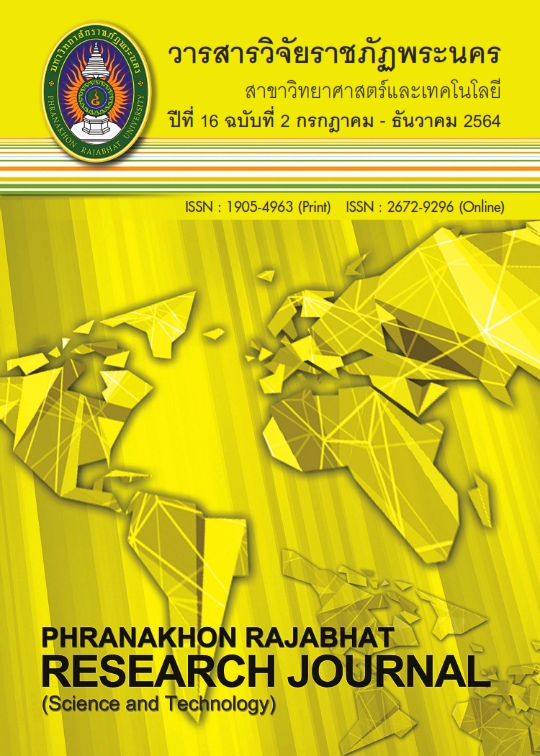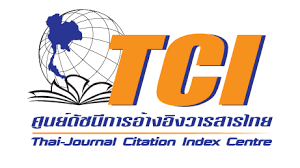ผลกระทบฝุ่น PM2.5 ต่อสุขลักษณะอาคาร กรณีศึกษาหอจดหมายเหตุแห่งชาติ จันทบุรี
คำสำคัญ:
ฝุ่น PM2.5, สุขลักษณะอาคาร, อาคารหอจดหมายเหตุ, อาคารอยู่อาศัย, อาคารสาธารณะบทคัดย่อ
การวิจัยครั้งนี้มีวัตถุประสงค์เพื่อวิเคราะห์หาค่าความข้นของฝุ่น PM2.5 และเปรียบเทียบค่าเฉลี่ยฝุ่น PM2.5 ภายในอาคารหอจดหมายเหตุแห่งชาติ จันทบุรี ที่เป็นห้องระบบเปิด ระบบปิด และภายนอกอาคาร เป็นการวิจัยเชิงสำรวจแบบภาคตัดขวาง ณ จุดเวลาใดเวลาหนึ่ง เลือกตัวอย่างแบบเจาะจง ได้แก่ กลุ่มห้องภายในอาคารที่เป็นระบบเปิด กลุ่มห้องภายในอาคารที่เป็นระบบปิด กลุ่มพื้นที่ภายนอกอาคารบริเวณทางเข้า กลุ่มละ 3 จุด แต่ละจุดตรวจวัดค่าเฉลี่ยรายชั่วโมง 8 ชั่วโมงต่อเนื่อง รวม 72 ตัวอย่าง ด้วยเครื่อง DUSTTRAK DRX Aerosol Monitor เปรียบเทียบข้อมูลที่ได้กับเกณฑ์มาตรฐานคุณภาพอากาศภายในอาคารที่เสนอแนะโดยกรมอนามัย สถิติที่ใช้วิเคราะห์ข้อมูล ได้แก่ ค่าเฉลี่ย ( ) ส่วนเบี่ยงเบนมาตรฐาน (S.D.) ใช้ F-test ทดสอบการกระจายของข้อมูล ทดสอบความแตกต่างของฝุ่น PM2.5 ด้วยสถิติ Kruskal-Wallis test และ Mann-Whitney U test ผลการวิจัยพบว่าความเข้มข้นของฝุ่น PM2.5 มีค่าอยู่ในช่วง 28 - 82 ไมโครกรัมต่อลูกบาศก์เมตร และมีค่าเฉลี่ยอยู่ในช่วง 28.4 - 73.5 ไมโครกรัมต่อลูกบาศก์เมตร ห้องที่มีค่าสูงเกินเกณฑ์มาตรฐาน ได้แก่ ห้องปฏิบัติงานตรวจสอบและประเมินคุณค่าเอกสาร ห้องปฏิบัติงานตรวจสอบและประเมินคุณค่าเอกสารประเภทฟิล์ม ห้องสำนักงานหอจดหมายเหตุ (ห้องธุรการ) ห้องศูนย์เอกสาร กลุ่มห้องที่เป็นระบบเปิดมีค่าเฉลี่ยฝุ่นสูงกว่ากลุ่มห้องที่เป็นระบบปิด อย่างมีนัยสําคัญทางสถิติ (p < .05) กลุ่มห้องที่เป็นระบบเปิดมีค่าเฉลี่ยฝุ่นไม่แตกต่างจากกลุ่มพื้นที่ภายนอกอาคาร (p > .05) กลุ่มห้องภายในอาคารที่เป็นระบบปิดมีค่าเฉลี่ยฝุ่น PM2.5 ต่ำกว่ากลุ่มพื้นที่ภายนอกอาคารบริเวณทางเข้า อย่างมีนัยสําคัญทางสถิติ (p < .05) ข้อเสนอแนะการปรับปรุงตามหลักการสุขาภิบาลอาคารหรือที่อยู่อาศัยให้ถูกสุขลักษณะ ด้วยวิธีการปิดประตู-หน้าต่าง ช่องว่าง หรือรอยรั่วต่างๆ ที่สามารถทำได้ง่าย มีค่าใช้จ่ายน้อย เหมาะกับอาคารบ้านเรือนที่อยู่อาศัยและอาคารสาธารณะเพื่อสุขลักษณะที่ดีปลอดภัยต่อผู้อยู่อาศัย
References
Bureau of Environmental Health. (2016). Indoor air quality assessment operation manual for staff. Nonthaburi: Department of Health, Ministry of Public Health.
Department of Disease Control. (2019). Guidelines for surveillance of health impacts from particulate matter up to 2.5 microns (PM2.5). Retrieved from https://pher.moph.go.th/wordpress/wp-content/uploads/2019/11/ /pdf [2021, 1 Apr.]
Kanidta, C., & Natphasuth, P. (2020). Emission source impact and problem solving and management on PM 2.5 in the northern part of Thailand. Journal of the Association of Researchers, 25(1), 461-474.
Katika, S., Kannalinya, B., Sirsawaranys, S., & Yuparat, K. (2016). Exploration of airborne fungi in research building, Faculty of Science Ubon Ratchathani University. Retrieved from http://repository.rmutr.ac.th/bitstream/handle/123456789/273/50.BInno2016-1005-86.pdf?sequence=1&isAllowed=y [2018, 12 Nov.]
Mašková, L., Smolík, J., & Vodicka, P. (2015). Characterisation of particulate matter in different types of archives. Atmospheric Environment, 107, 217-224.
Ministry of Public Health. (2021). Health data center (HDC). Retrieved from https://hdcservice. moph.go.th/hdc/reports/report.php?source=pformated/format1.php&cat_id=9c647c1f31ac73f4396c2cf987e7448a&id=297c1cb035778f7b49357693e6867e6c [2021, 24 Jun.]
Office of the Royal Society. (2011). Dictionary of the Royal Institute of Thailand 2011. Retrieved from https://dictionary.orst.go.th [2021, 1 Apr.]
Provincial Office of Natural Resources and Environment Chanthaburi. (2021). PM2.5 & hotspot NEWS. Retrieved from http://chanthaburi.mnre.go.th/th/news/more/140/page/1 [2021, 24 Jun.]
Royal Thai Government Gazette. (2010). National Environment Board Announcement No. 36 (2010) subject: Standards for particulate matter with a size of not more than 2.5 microns in the ambient air. Retrieved from http://www.ratchakitcha.soc.go.th/DATA/PDF/2553/E/037/61.PDF [2021, 1 Apr.]
Royal Thai Government Gazette. (2019). Notification of the Pollution Control Department subject: Measuring instruments and methods for measuring the average value of gases or particulates in the ambient air, other systems or other methods approved by the Pollution Control Department. Retrieved from http://www.ratchakitcha.soc.go.th/DATA/PDF/2562/E/259/T_0037.PDF [2021, 1 Apr.]
Sumontarikan, M., Onanong, W., Benjamas, T., Chavinthorn, M., Wirakorn, T., Sitthiphan, C., & Sukon, K. (2018). Occupational health hazards in the national archive and its branches –archivists and scientists’ attitude. Safety and Environment Review E-Journal, 1(1), 28-33.
World Health Organization. (2016). Air pollution and health. Retrieved from https://www.who.int/docs/default-source/searo/wsh-och-searo/01-th-air-pollution-get-fold-leaflet-web.pdf?sfvrsn=1b7437f8_2 [2021, 1 Apr.]
Worrawut, K. (2017). Effects of particulate matter (PM10) from road traffic on students’s health: case study of Phra Pathom Witthayalai School Mueang District, Nakhon Pathom Province. (Master degree). Silpakorn University, Mueang District, Nakhon Pathom Province.
Downloads
เผยแพร่แล้ว
ฉบับ
บท
License
โปรดกรอกเอกสารและลงนาม "หนังสือรับรองให้ตีพิมพ์บทความในวารสารวิจัยมหาวิทยาลัยราชภัฏพระนคร สาขาวิทยาศาสตร์และเทคโนโลยี" ก่อนการตีพิมพ์



